Closed exhibition - M.F. Husain: Master of Modern Indian Painting
M.F. Husain Lithographs at the V&A
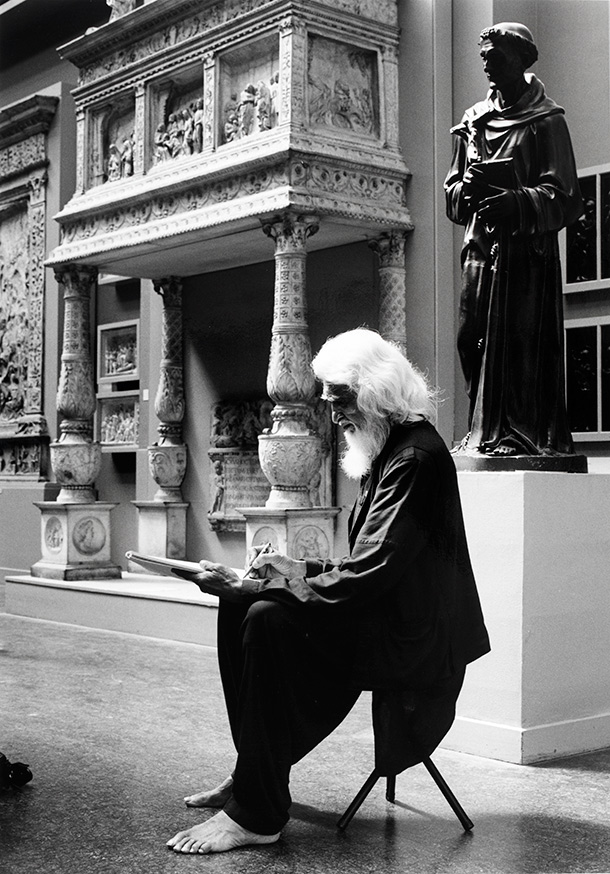
M.F. Husain in the Cast Courts at the V&A, 1990. © Victoria and Albert Museum, London
Maqbool Fida Husain, known as M.F. Husain, was one of the most renowned Indian artists of the Twentieth-Century. Gaining artistic recognition in a newly independent India, Husain’s paintings incorporate the vivid richness and iconography of centuries of Indian art with a modern, semi-abstract style that was greatly influenced by the masters of Twentieth-Century European painting.
Husain was born on 17th September 1915 into a large, working-class Muslim family in the town of Pandharpur, in the state of Maharashtra, in central India. The instability of the family’s financial situation meant that Husain received a haphazard and largely informal education, and, despite gaining admittance to the Mumbai J.J. School of Art in 1934, he was unable to take up his place. Three years later, Husain finally moved to Mumbai where he worked during the day as a ‘graphic wallah’, painting the huge cinema hoardings that advertised the thriving Bollywood film industry. At night he worked on his own paintings, eventually achieving recognition as an artist in 1947 when his own work was exhibited at the Bombay Art Society. Concurrently, he became a founder-member of the Progressive Artists’ Group alongside other prominent modern Indian artists, such as Francis Newton Souza and Syed Heider Raza. The founding principle of this movement was to embrace the styles of the international avant-garde art movements of the Twentieth-Century, while rejecting the nationalist style of art developed and promoted by the Bengal School.
Husain became one of the most popular painters in India with a prolific output of work. Soon achieving a national and international reputation, his works were acquired by museums and galleries worldwide. A secular Muslim, Husain drew much of the subject matter for his art from traditional Indian festivals, rituals, mythology and literature. He was also inspired by the richness of colour found in traditional Indian paintings and the iconic forms of Indian sculpture. He was particularly influenced by Basholi artists from the Punjab Hills, who combined bold pigments with a distinctive flatness of line.
The last quarter of the Twentieth-Century saw Husain’s life clouded by controversy, brought on by objections to the style of his portrayal of nude Hindu deities. Protests against his art escalated and led to attacks on his home and paintings, so much so that, at the end of his life he lived in self-imposed exile between Doha and London. He died in London on 9th June 2011 aged 95, still working on a series of large triptychs, ‘Indian Civilization’, which celebrate India’s history, culture and people.
In the early 1980’s, the V&A acquired two series of lithographs by Husain, each comprising ten prints. The contrasting subject matter of these two series of images typifies Husain’s interest in both contemporary Indian culture and traditional mythology. One set depicts scenes from the adventures of the Hindu monkey god Hanuman in the popular epic, the Ramayana. In these exploits, Hanuman tirelessly assists Rama and Lakshmana in recovering Rama’s wife, Sita, who has been captured by the many-headed demon king, Ravana.
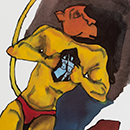
M.F. Husain, Hanuman
M.F. Husain
Hanuman
1982
Lithograph
Museum no. IS.104B-1983
© Victoria and Albert Museum, LondonIn this image, Hanuman bears open his chest to reveal Rama and Sita nestling in his heart.
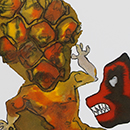
M.F. Husain, Hanuman
M.F. Husain
Hanuman
1982
Lithograph
Museum no. IS.104C-1983
© Victoria and Albert Museum, LondonThis image depicts Hanuman baring his teeth as he prepares for one of his many battles with Ravana.
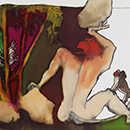
M.F. Husain, Hanuman
M.F. Husain
Hanuman
1982
Lithograph
Museum no. IS.104J-1983
© Victoria and Albert Museum, LondonIn the final image in the series, Hanuman and a small group of monkeys are surrounded by the deep green foliage of the jungle.
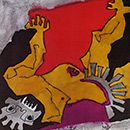
M.F. Husain, Hanuman
M.F. Husain
Hanuman
1982
Lithograph
Museum no. IS.104I-1983
© Victoria and Albert Museum, LondonLithograph depicting Hanuman fighting a demon.
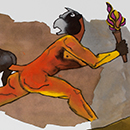
M.F. Husain, Hanuman
M.F. Husain
Hanuman
1982
Lithograph
Museum no. IS.104H-1983
© Victoria and Albert Museum, LondonLithograph depicting Hanuman in orange-yellow colours, running with a blazing torch. A nude female figure is shown clinging to his tail.
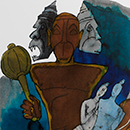
M.F. Husain, Hanuman
M.F. Husain
Hanuman
1982
Lithograph
Museum no. IS.104HE-1983
© Victoria and Albert Museum, LondonLithograph depicting a three-headed Hanuman, seated and holding a club. In front of him are two diminutive figures of Rama and Sita.
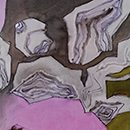
M.F. Husain, Hanuman
M.F. Husain
Hanuman
1982
Lithograph
Museum no. IS.104G-1983
© Victoria and Albert Museum, LondonLithograph depicting Hanuman in a semi-abstract manner in grey, mauve, green and brown colours.
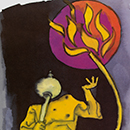
M.F. Husain, Hanuman
M.F. Husain
Hanuman
1982
Lithograph
Museum no. IS.104F-1983
© Victoria and Albert Museum, LondonLithograph depicting a yellow Hanuman setting fire to Lanka with his flaming tail.
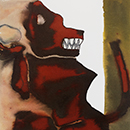
M.F. Husain, Hanuman
M.F. Husain
Hanuman
1982
Lithograph
Museum no. IS.104A-1983
© Victoria and Albert Museum, LondonLithograph depicting a reddish-brown Hanuman with bared teeth, about to hurl a rock.
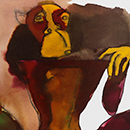
M.F. Husain, Hanuman
M.F. Husain
Hanuman
1982
Lithograph
Museum no. IS.104D-1983
© Victoria and Albert Museum, LondonLithograph depicting a seated Hanuman in orange-brown, bright magenta and yellow colours.

M.F. Husain, 'Mother and Child: A Tribute to Mother Theresa, the Great Humanist of our Time'
M.F. Husain
'Mother and Child: A Tribute to Mother Theresa, the Great Humanist of our Time'
1980
Lithograph
Museum no. IS.21G-1982
© Victoria and Albert Museum, LondonIn this print, the figure of a dying youth lying across the lap of a faceless nun echoes the Lamentation, where the figure of a dead Christ is cradled in the lap of his mother, the Virgin Mary.
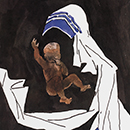
M.F. Husain, 'Mother and Child: A Tribute to Mother Theresa, the Great Humanist of our Time'
M.F. Husain
'Mother and Child: A Tribute to Mother Theresa, the Great Humanist of our Time'
1980
Lithograph
Museum no. IS.21E-1982
© Victoria and Albert Museum, LondonIn a second work, the semi-abstract figure of a nun sits with a baby on her lap whilst another child peeps out from behind the distinctive blue and white cloth. Here Husain draws on traditional devotional images of the Virgin Mary with the Christ Child, who were often portrayed with a young St John the Baptist. In the lithographed text that accompanies this series of images Husain writes: 'Mother and Child: a Tribute to Mother Theresa, the great humanist of our time'.
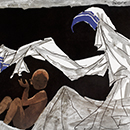
M.F. Husain, 'Mother and Child: A Tribute to Mother Theresa, the Great Humanist of our Time'
M.F. Husain
'Mother and Child: A Tribute to Mother Theresa, the Great Humanist of our Time'
1980
Lithograph
Museum no. IS.21C-1982
© Victoria and Albert Museum, London
M.F. Husain, 'Mother and Child: A Tribute to Mother Theresa, the Great Humanist of our Time'
M.F. Husain
'Mother and Child: a Tribute to Mother Theresa, the Great Humanist of our Time'
1980
Lithograph
Museum no. IS.21I-1982
© Victoria and Albert Museum, LondonThis lithograph depicts a malnourished child, with a swollen stomach and a nun's robe billowing across the picture.
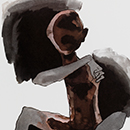
M.F. Husain, 'Mother and Child: A Tribute to Mother Theresa, the Great Humanist of our Time'
M.F. Husain
'Mother and Child: A Tribute to Mother Theresa, the Great Humanist of our Time'
1980
Lithograph
Museum no. IS.21J-1982
© Victoria and Albert Museum, LondonThis lithograph depicts an emaciated, seated male figure.
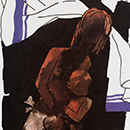
M.F. Husain, 'Mother and Child: A Tribute to Mother Theresa, the Great Humanist of our Time'
M.F. Husain
'Mother and Child: A Tribute to Mother Theresa, the Great Humanist of our Time'
1980
Lithograph
Museum no. IS.21F-1982
© Victoria and Albert Museum, LondonThis lithograph depicts a woman and two infants, a nun's robe billowing above.
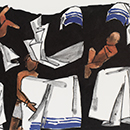
M.F. Husain, 'Mother and Child: A Tribute to Mother Theresa, the Great Humanist of our Time'
M.F. Husain
'Mother and Child: A Tribute to Mother Theresa, the Great Humanist of our Time'
1980
Lithograph
Museum no. IS.21B-1982
© Victoria and Albert Museum, LondonThis lithograph depicts two nuns and two infants.
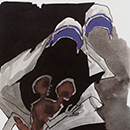
M.F. Husain, 'Mother and Child: A Tribute to Mother Theresa, the Great Humanist of our Time'
M.F. Husain
'Mother and Child: A Tribute to Mother Theresa, the Great Humanist of our Time'
1980
Lithograph
Museum no. IS.21A-1982
© Victoria and Albert Museum, LondonThis lithograph depicts a mother and child.
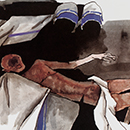
M.F. Husain, 'Mother and Child: A Tribute to Mother Theresa, the Great Humanist of our Time'
M.F. Husain
'Mother and Child: A Tribute to Mother Theresa, the Great Humanist of our Time'
1980
Lithograph
Museum no. IS.21H-1982
© Victoria and Albert Museum, LondonThis lithograph depicts two nuns and a piéta-like figure.
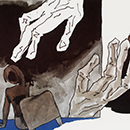
M.F. Husain, 'Mother and Child: A Tribute to Mother Theresa, the Great Humanist of our Time'
M.F. Husain
'Mother and Child: A Tribute to Mother Theresa, the Great Humanist of our Time'
1980
Lithograph
Museum no. IS.21D-1982
© Victoria and Albert Museum, LondonThis lithograph depicts two large outstretched hands, a seated woman and a child.
With thanks to Mrs Usha Mittal
With kind support from Christie's
Contents
What's on at the V&A?
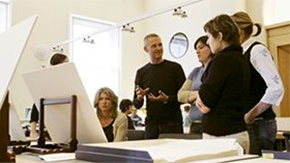
Explore the V&A's huge range of events about the designed world, from blockbuster exhibitions to intimate displays and installations, world-class talks, casual and accredited training courses and conferences with expert contemporary speakers. Browse, search and book onto our unrivalled event programme for all ages and levels of expertise.
Book onto a great event now